In this paper, we shall study the facts and figures of the Lloyd’s Building, London and understand the circumstances prevailing at that time. Even though Richard Rogers was a renowned architect, there were some people who were not impressed by his designs. Probably, the reason was that Rogers was a modernist and designed building based on futuristic vision.
The buildings designed by him were in contrast with the old designs. But Rogers took precautions that his designs did not have a demeaning effect on the surroundings. Gradually Rogers started getting appreciation and won great accolades. The Lloyd’s Building is one of his master pieces that stand tall even today.
The name of Lloyd’s Building was derived from Edward Lloyd’s Coffee House during the years of 1700. The coffee shop was used as a meeting place where owners of ships used to meet the insurers in order to decide the insurance premiums of various shipments.
Phillips said, “The Lloyd’s insurance market has always been a place of ‘information exchange’: in its early days this was carried out in the coffee house run by Edwin Lloyd, where sea captains and financiers met to exchange information on shipping and the movement of cargo” (Phillips). During the ensuing 300 years, Lloyds became a synonym for insurance and today, it is a world renowned name in the insurance sector.
After two earlier buildings (1928 and 1958) were felt to be small and keeping in view the increasing customer base, during the year 1970, London’s Lloyd insurers hired Richard Rogers as architect for their innovative headquarters to be constructed on One Lime Street in London, England.
Richard Rogers was a renowned architect famous for his modern designs. Powell et al suggested that, “The Lloyd’s Building epitomizes Richard Rogers’ concern with overt technical imagery” (Powell and Rogers). The main contractor for the project was Bovis.
The structural services engineers were Ove Arup & Partners. Lloyds wanted to build up their worldwide image by constructing this building with a unique design. In creating the design of the Lloyd’s Building, Rogers took inspiration from his earlier jobs. “Rogers’ sources for the building were many. The immediate precedent is his Pompidou Centre, Paris (1971), which he designed with Renzo Piano” (Riba).
At the time when the construction of the Lloyd’s Building started, the British government was in the process of bringing about some major changes in the government policies, mainly pertaining to the labor class.
Some changes that were being proposed were: increasing the labor opportunities, increasing self employment opportunities, improving the market conditions of women laborers, etc. Margaret Thatcher tried to improve the employment conditions in the United Kingdom but in this process, the Union powers experienced a decrease.
Also, the reforms were not able to improve the wages to the unemployed. But of course, there was a substantial decrease in the unemployment. In such circumstances, the construction of the Lloyd’s Building was welcomed by the labor class as many job opportunities were created.
The construction of the building started in the year 1978 and it was completed in 1986. Lloyd’s Building was inaugurated on 18 November 1986 by Queen Elizabeth II. The total cost incurred was $107,876,055.44.
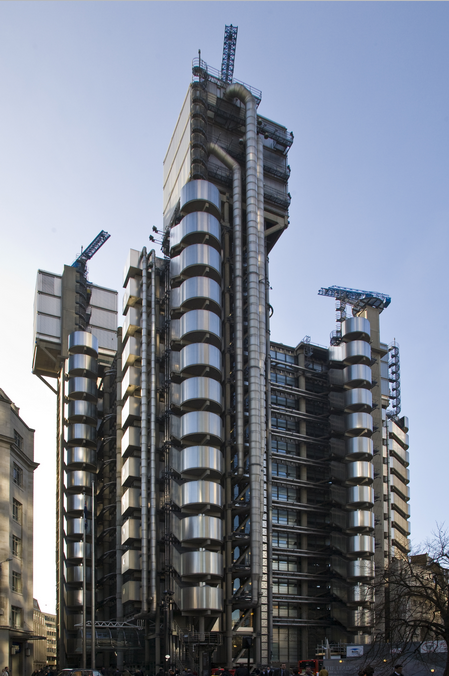
The building was unique in the sense that all the utilities were designed to be located towards the exterior. Utilities include conduit and water pipes, lifts, stairs, and toilets. This was done in order to create more inner space.
It was intended to provide ample space for various functions of the office. Richard was quite successful in his endeavor of creating a modern look for the building. The building got a good appreciation from the public as well since it blended with the surrounding buildings and did not diminish the look of the ‘Square Mile’ area.
Huge quantities of concrete, to the tune of 1,183,394 cubic feet, were used in the construction of the building. The quantity of glass used for creating the curtain wall effect was 129,166 square feet. The steel cladding was done using 322,917 square feet of stainless steel. In addition to the stainless steel, 53,819 square feet of aluminum and 21,527 square feet of painted steel were also used. 140,000 meters of gasket (for sealing the windows) and 80,000 meters of ducts and pipes were used.
There are six towers that are part of the building. Three of these are main towers and the rest are for service purpose. Cleaning cranes are installed on top of the three service towers. The service towers housed all the utilities like lifts, bathrooms, machinery rooms, etc. This was done in order to keep the work flow smooth and without any sort of disturbance caused due to repairs and maintenance. These six towers surround a rectangular space.
The building consists of fourteen floors that are easily accessible by twelve glass lifts. These kinds of glass lifts were used for the first time in the whole of the United Kingdom. The building also has zigzag staircases that can be used for access to the lower floors. The building also boasts of having special lifts for cars that take them to the underground parking area. The atrium or the reception area of the building is massive and the famous Lutine Bell is installed here. This area is also called as the ‘Underwriting Room’.
The height of this room is 197 feet and it has a glass ceiling that allows natural light into the area. The bell is of great significance. The Lloyds had insured a cargo ship named HMS Lutine. Unfortunately, the ship, with huge treasures, sank and only the bell could be recovered during 1860. Since then, it has been a tradition to sound the bell once if there is any good news and twice if there is any bad news.
The actual height of the building is 289 feet but if the cranes installed on the service towers are taken into consideration, the height becomes 312 feet. The building was designed in such a manner that any changes in the floor plans were easily possible. According to the initial design, the lower four floors had balconies while the rest of the floors were closed with glass sheets.
The building was constructed keeping in consideration the vertical expansion system. The framework of the towers constitutes of vertical columns, horizontal beams and slabs. It is noteworthy that all these were prefabricated at other facilities and then were brought at the site and fixed.
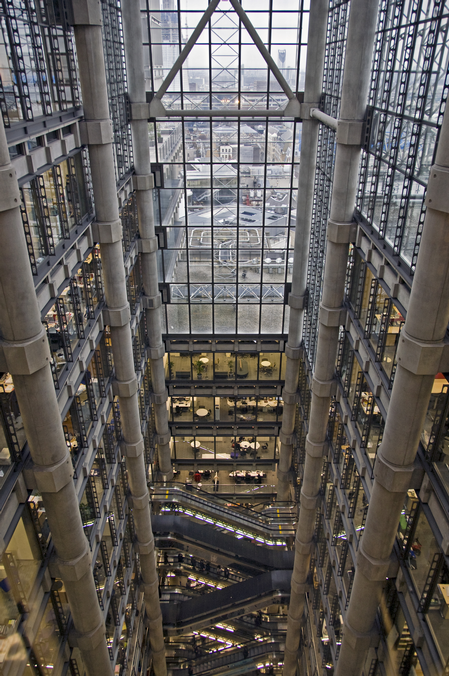
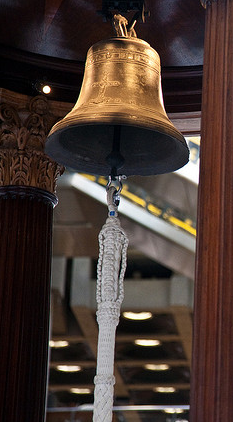
One peculiar thing about the Lloyd’s Building is that the Committee Room, housed on the eleventh floor, was shifted as it is from the old Lloyd’s Building. Pieces from the old building were removed from the old building and placed in the new one in exactly the same fashion.

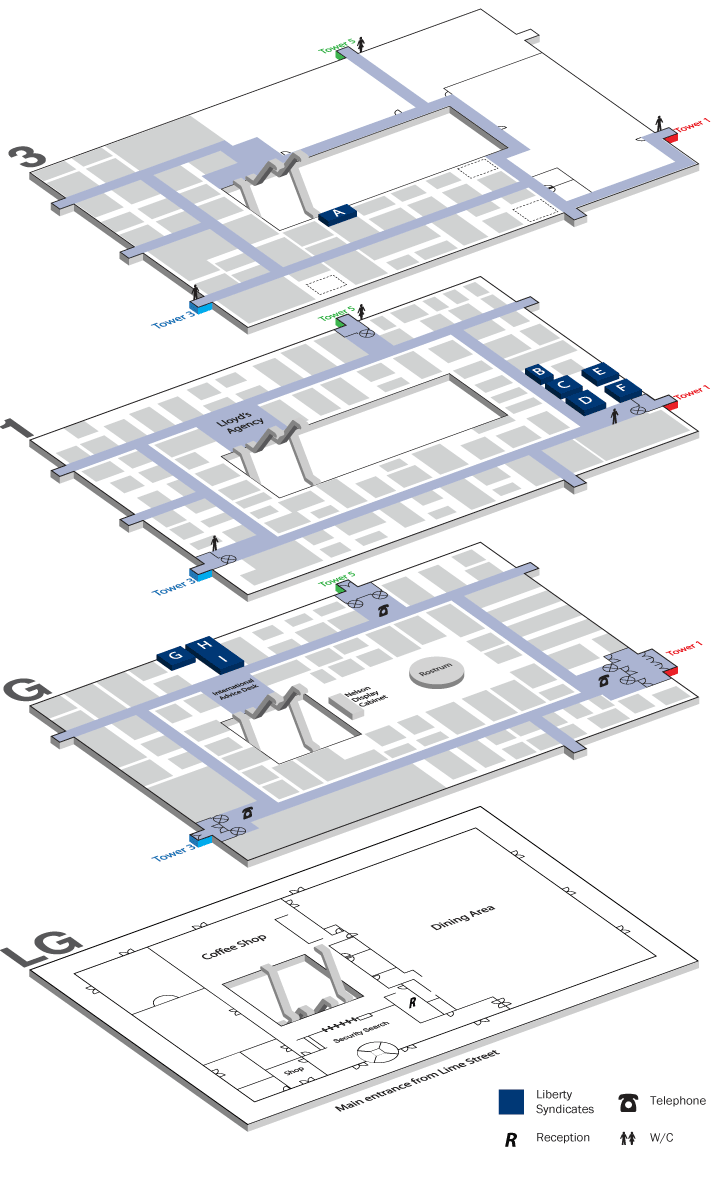
The building won various accolades and prizes such as the coveted Eternit 8th International Prize for Architecture in 1988 and the PA Award for Innovation in Building Design and Construction, in 1988. The Twentieth Century Society promoted Lloyd’s Building to be included in the Grade I listed buildings.
It took almost three years, when in 2011 the Lloyd’s Building was declared as being a Grade I building. In Roger Bowdler’s words, “The Lloyd’s building designed by the Richard Rogers Partnership stands the test of time with its awe-inspiring futuristic design which exemplifies the High Tech style of Britain. It clearly merits the extra protection against unsuitable alteration or development that listing provides” (as cited by Waite).
But not everyone was happy or convinced with the decision of granting the Lloyd’s Building a Grade I listing status. According to Owen Hatherley, “There should be no doubt whatsoever that Lloyd’s deserves its listing. But for a building so famous, Lloyd’s is not well served by writers and historians. It is usually interpreted in one of two completely inadequate ways” (Hatherley).
Lloyd’s Building has been used as a picture shooting location for many films such as Ashes to Ashes, The Outer Limits, Spy Game, The Avengers, Incredible Games, etc.
It has been almost 26 years that Lloyd’s building was constructed. During these years, there have been a lot many changes in all spheres of live, including the construction machineries. The manual labor for such heavy works has been reduced to almost negligible. At the same time, accuracy and perfection have increased. Even the time of completion of any particular work has decreased. The role of manual labor has decreased.
But in place of the manual labor specialized labor is required. In other words, it has become very crucial for laborers to undergo some vocational training. Even the construction materials have improved in quality and strength. But due to massive competition in the construction market, the profit margin has gone down. As a result, construction companies don’t want to spend much on its employees’ training and other requirements. As a result, there have been many unsatisfied customers as far as the workmanship is concerned.
Talking of the Lloyd’s Building, if it were to be constructed in today’s circumstances, there would have been many differences. The major difference would have been the time period for completion. It took almost eight years to complete the building. But during recent times, owing to the technological developments, the time taken would be reduced to a great extent. Another major difference would have been the cost factor.
If the currency inflation is taken into consideration, the cost of constructing the Lloyd’s Building in recent times would be much less. This is because most of the work would have been done by machines and it is understood that machines are cheaper than human beings. Also, the quality of the materials used would have been better that would result in more durability. The life of the building, which was initially set to fifty years, would have been more in case it was constructed in recent times.
There are certain changes that would have been welcomed by the majority. First of all, the lifts should have been towards the inner side of the towers instead of the outer side. This may be said to be a privacy concern. Anyone can see people going up and coming down by simply standing outside in the lane. So in my opinion, the lifts should have been on the inner side.
It was a well thought idea of Rogers in keeping all the wash rooms in the service towers. But he forgot to take into consideration the time taken by people to go all the way from their offices to the wash rooms. In my opinion, the washrooms should have been near the offices. This would have saved a lot of man hours.
If repairs and maintenance was thought to be a disturbing process, the doors of the wash rooms could have been blocked by some partition in such a manner that a person going to the washroom can enter the washroom but no one can see him/her entering the wash room. What I mean to say is that the direct view of the wash rooms could have been blocked instead of shifting them completely in another tower.
Another change that I would have suggested is that the lifts installed for taking the cars to the lower levels where the parking lots were located, could have been avoided. Instead, ramps should have been constructed. This would have saved the recurring expenses of the lift such as electricity, repairs and maintenance, etc.
My other concern is related to the health of people working on the higher floors after the fourth one. From what we have studied, it is evident that up to fourth floor, people have access to balconies. But fifth floor onwards, there are no balconies. The building is covered with glass walls.
This means there are no windows as well. In order to keep healthy, fresh air is a must. But people working on the upper floors, after the fourth one, don’t have access to fresh air. It is understood that there might be heaters and/or air conditioners but in my opinion these all are artificial things made for comfort. The health aspect has not been considered.
From ‘Picture 6’ below, it is evident that there are no separate cabins or rooms for people working on different floors. Tables and chairs can be seen adjusted for people to work. In my opinion this is not a good office culture. If a person talks over the telephone, another one can listen.
Moreover, if two people talk to each other, other people working near by might get disturbed. Means there is no sound barrier. There may be circumstances when people at a floor talk loudly which may disturb people on the other floors. So in my opinion this should have been changed and small cabins should have been erected.
If the cost factor was supposed to be a constraint then the option would have been half partitions. By doing this, at least the horizontal travel of sound could have been contained to a great extent. Another disadvantage of this open office system is that people sitting at their table have a direct view of the escalators. Sometimes this might be quite distracting. As a result, the competence of the staff will be affected.

‘Picture 7’ below portrays the exterior of the Lloyd’s Building. At first look, it seems to be some industrial unit where bib pipelines are required. A layman will obviously take it to be some factory or something. In my opinion, the exterior design should have been changed in such a way that there were no pipes visible. A better option could be to cover all such pipes and ducts with some sort of covering that would compliment the whole building.
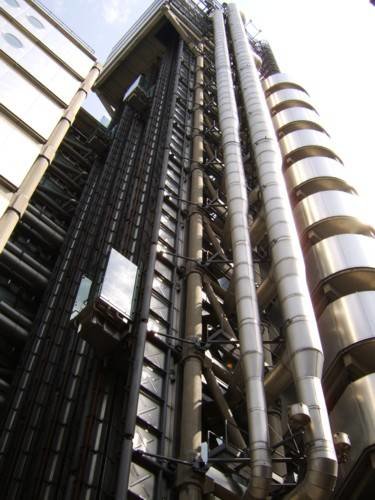
It is understood that the Lloyd’s Building’s exterior is made out of steel and glass. Both these materials require regular cleaning. This involves too many expenses. In the process of creating a unique building, Rogers created a mine of expenses. Rogers could have used some stones, granites etc on the outer walls of the towers.
Even though there are many exterior lifts now days, the concept doesn’t convince me. It is very risky. In case of any mishap, there is nothing that the lift can hold on. In the traditional lifts, there are at least walls on all the four sides and there are chances of safety. But in the external lifts, during any mishap, people in the lift will straight away plunge to their deaths. So in my opinion, instead of external lifts, Rogers should have designed the covered lift system.
Works Cited
Hatherley, Owen. The Lloyd’s Building is a Time Machine. 2011. Web.
Phillips, Nicolas. “The Lloyd’s Building.” Journal of Corporate Real Estate 1.3 (1999): 1-4. Print.
Powell, Kenneth and R. Rogers. Lloyd’s Building: Richard Rogers Partnership, USA, Phaidon, 1994. Print.
Riba. Interior of Lloyds Building. n.d. Web.
Waite, Richard. Rogers’ Lloyd’s Becomes Youngest Grade-I Listed Building. 2011. Web.